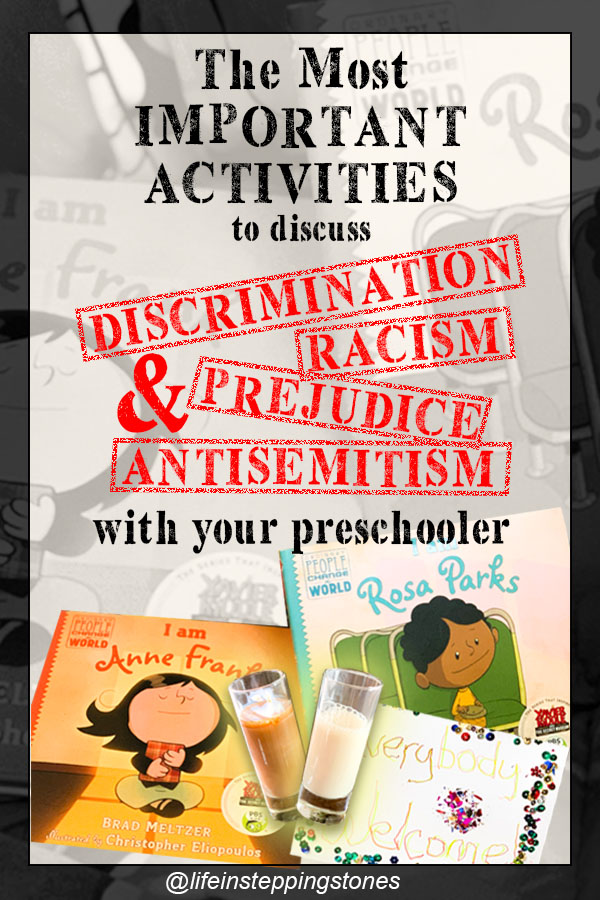
I was hesitant to say the least about the topic of yesterday’s theme day, as I wanted to make sure I approached the subjects correctly. I researched far and wide across the internet and mostly, I came up short. There are a lot of people who feel prejudice is too sensitive of a topic for kids, especially around the preschool/kindergarten/early elementary school age. But I thought about it. When you’re black, or Jewish (as I am), you don’t choose at five years old not to be discriminated against. You don’t choose if people threaten you or insult you because of how you look or because you choose to wear your Jewish star. You don’t choose if people look down on you because there’s something they decided they don’t like. You don’t choose whether your holidays are completely ignored by every public school and your slapped with days of makeup work assignments because you stayed home for a Jewish holiday. Prejudice, racism, antisemitism, ignorance, and hate doesn’t have an age. Maybe this is because I grew up watching Party of Five at four with my parents and learned about topics that were also deemed “inappropriate” for my age, but I feel very strongly that kids can handle a lot more than they are given credit for.
In my research for today’s assignments, I found mostly websites dissuading people from teaching these lessons. People saying it was too mature of a topic for small children. People saying discussing it will create racism in your child. I don’t believe that. I believe education on these powerful topics is key to changing our world. Amazingly, most of these comments came from people who don’t want racism and hate that it exists, yet they don’t understand how vital it is that children learn these lessons early on. We don’t want to create children who ignore the hate around them. We don’t want to create children who are colorblind or blind to how other people are treated for their faith. We don’t want to create children who are ignorant to other people’s problems. To promote real change, it begins with real understanding.
Storytime
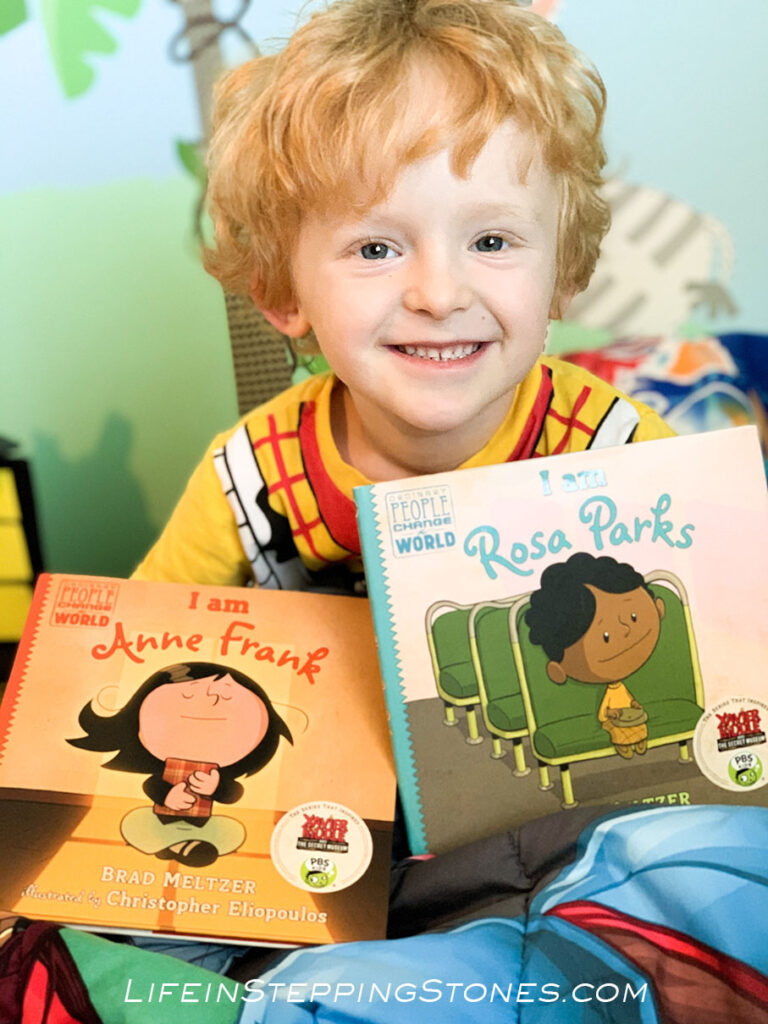
My lesson began the night before. My son crawled into bed and we pulled out the new book we bought from the Ordinary People Change the World series. It was “I Am Anne Frank”. Honestly, I didn’t know it was possible for a writer to explain the Holocaust and antisemitism in a way that a five year old could understand. It was perfectly written. Informative enough that my son was asking questions, and tame enough that he wasn’t traumatized when going to sleep, but it still made him think. Three quarters of the way through the story, I started crying. Bailey could see the effect this story had on me. It was an effect I didn’t even know about until I read the book. I spent my childhood believing that this was so long again that it could never happen again. I knew it was horrific but I didn’t personally feel the pain of it. For the most part, as a child, I chose not to wear my Jewish star and felt hesitant to tell people I was Jewish. I didn’t know why I felt this why, but I largely ignored the feeling. Now, with our current political climate, I understand. These feelings of antisemitism and racism have always been there among some people, but now, it feels more real to me than ever. Hate has been brought into the light these past four years and the underlying feelings and fears I carried as a child, have been put into the spotlight for people of various religions, races, sexuality, and gender. People have been encouraged these past four years to be cruel and insult people for who they naturally are. People have been encouraged to blame people who are naturally different from them for their problems and fears. This attitude is exactly what led to the Holocaust.
My son asked me how Anne Frank died. He asked me if the Nazis died. He told me it was a sad story but I explained to him the beauty of Anne Frank’s hope throughout it. That even though she died, and even though she lived two years in hiding, she saw the beauty in everything around her and chose to feel love instead of hate.
The following morning, we read “I Am Rosa Parks”. After reading the story, we flipped back through the pages as I discussed the different experiences that Rosa went through. I asked Bailey how he would feel if when we went to our park and if the water fountain right by the playground had a sign that said “No blue eyes allowed”, and he’d then have to walk all the way to the other end of the park just for a drink. He said it would make him feel really sad. I explained that Rosa lived every day of her life like that. Throughout the story, I’d ask Bailey the same question. “How would you feel if you couldn’t get on the front of a crowded bus because you had blue eyes?” “How would you feel if people threw trash at you because you had blue eyes?” “Sad”, he said. “That was mean”, referring to what happened in the book, he said. When the book came to the end, he shouted “Hooray!” because Rosa was finally allowed to sit anywhere she wanted on the bus, drink from any fountain she wanted, and enter any elevator she wanted.
Bus Craft
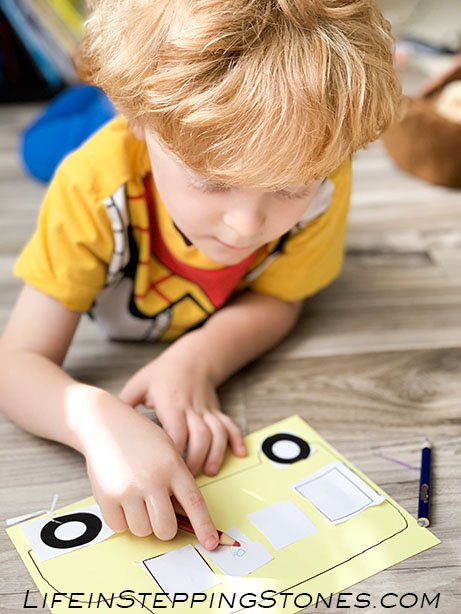
For our first activity, I created a paper bus. My son cut out the windows and the wheels, and drew people of all races inside the windows. It took some explaining to him and I had to remind him why we were doing the project a certain way. He saw four windows and immediately wanted to draw each member of our family, but that wasn’t the point of the project. He became frustrated with me but finally (after a short tantrum), he stopped, and listened, and heard me when I explained we weren’t drawing his story, we were drawing Rosa’s.
Does Color Matter? Activity
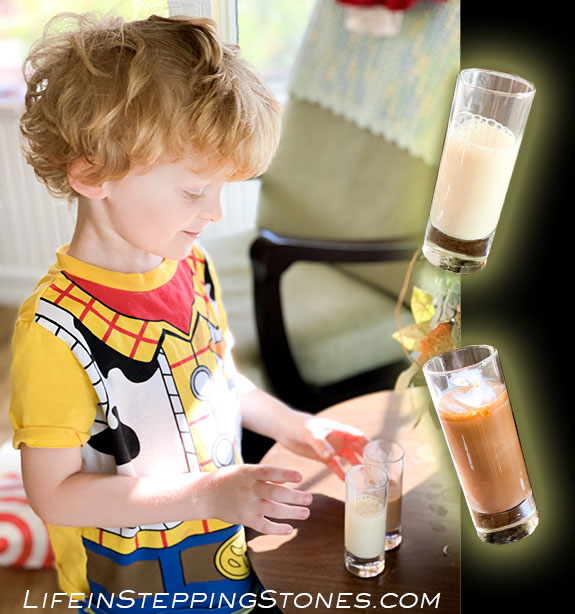
The one website I found that actually dealt with teaching a young child about racism, Surviving a Teacher’s Salary, gave me this idea. On the website, the mother suggested using a brown shelled egg and a white shelled egg, opening them up, cooking them, and asking the child if they can tell the difference. I didn’t have eggs for this experiment, plus there’s an egg shortage starting to happen at the stores again! Instead, I took out two small glasses of milk. I poured milk into each glass and added brown food coloring to one. When my son drank them, I asked him if one tasted different. He said no. I asked him if one tasted better. He said no. He said they taste the same. I asked him if the color made a difference in how they tasted. He shook his head, and once again, he said no. This activity opened up the chance to talk about how Rosa was treated differently just because her skin was a different color. I explained that even if people look different, we are all people on the inside. No one is better or worse than someone because of how they look.
No Blue Eyes Allowed! Activity
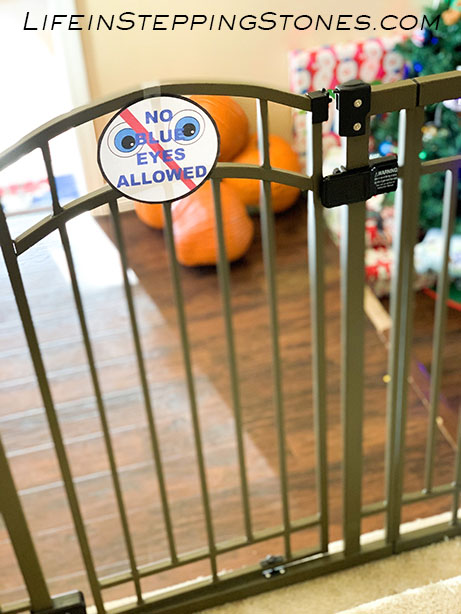
To give my son a sense of the segregation that Rosa and Anne both experienced, I set up signs around the house saying “No blue eyes allowed” and “blue eyes allowed”. I knew this activity would be a fine line between a powerful lesson and my son thinking it was a game (which I did not want to have happen). When I first put the signs up, he was excited. He thought it was going to be a fun game. We started downstairs in the bathroom where I put a sign that said “No Blue Eyes Allowed”. He had to go upstairs to use the bathroom. I put a sign at one entrance to the kitchen that said he wasn’t allowed, and a sign at the other side that said he was. He chased me, like he normally does, through the kitchen and found it was very unfair that I could tag him from wherever, and cross the line, but he had to constantly stop, turn around, and go the other way just to try and get me (which he never could, and this is a kid that loves to win). When he had to use the bathroom, he sighed in annoyance and headed upstairs. This is where things started to shift and the lesson truly began. While he was in the bathroom, I put a sign by the office door where he plays that said he wasn’t allowed. I put a sign at his bedroom that said he wasn’t allowed. And I put a sign at the bottom of the stairs that said he was no longer allowed. He started to get frustrated. Where could he go? He couldn’t go anywhere. Meanwhile, I was dancing downstairs, talking about getting myself a snack in the kitchen, and going about my day because I have green eyes. Within about 10 minutes, he was on the stairs pouting saying how unfair it was and that he wanted a snack, and he wanted to play. As a parent, there’s a fine line between teaching your child a lesson and causing a complete nightmare for yourself the rest of the day. Knowing that, I ended the activity at what I felt was the perfect time. He was understanding the point and the frustration that Rosa and Anne felt. I told him that’s how they felt every day with everything they did. He said that was wrong and people should be allowed anywhere. He then came up with the next activity…and I am so proud of him and his beautiful heart for thinking of it.
Everybody Welcome Sign Art Craft
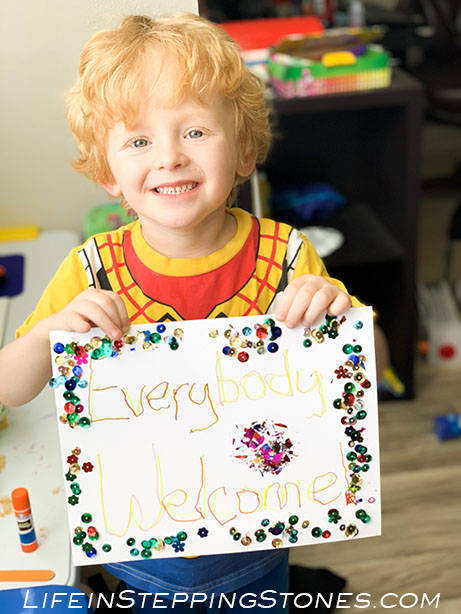
He turned to me after the “No Blue Eyes” segregation activity and said, “Mommy. We need to make a sign that says everybody is allowed and it needs to have lots of sequins!.” Beaming, I headed upstairs with him and we sat in the office. I wrote the words “Everybody Welcome” with a yellow highlighter and let him trace the letters with different markers. Afterwards, he smeared glue across it, tossed confetti over it, dropped sequins across the edges, and proudly showed it off to me. He said we needed to put the sign downstairs.
Settling in for a Movie
Originally, I planned to watch the Xavier Riddle and The Secret Museum episode about Rosa Parks. Sadly, it wasn’t available on the PBS app at this current time. We watched a short clip of it that was but I hope PBS Kids rereleases the full episode at some point. I also thought about watching The Sound of Music with him. We’ve watched it before but I wasn’t sure it would hold his attention the full way through. After doing a quick google search, I found three animated movies that were suggested to discuss the topic of racism. The movies included Hotel Transylvania 1, Finding Dory, and Zootopia. Having watched the first two before, I decided to go with Zootopia, and boy, am I glad I did. Honestly, before I read about it, I thought it was some movie about a zoo or something. I had no idea how in depth Disney got on the subject of racism and discrimination. I was truly blown away by this remarkable children’s movie and it is hands down their best.
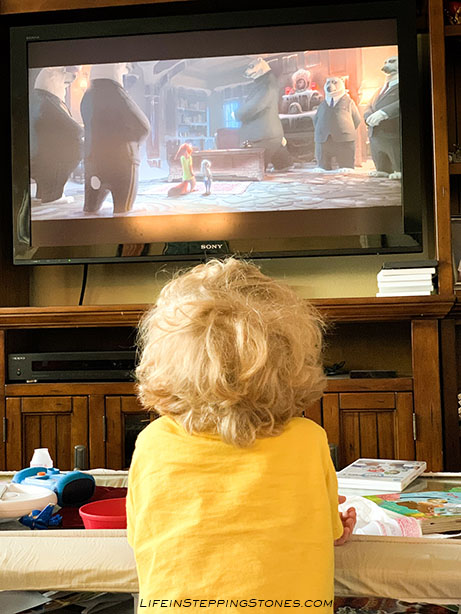
For those who haven’t seen it, I don’t want to spoil it, so skip this paragraph and move onto the next! The movie is about a female bunny, Hopps, who dreams of being a cop. She ends up hired in her dream job through an affirmative action type program and then gets given the job of meter tickets because her boss doesn’t think she can do anything else. Along the way, she makes friends with a fox named Nick, even though her bunny family had always warned her against them because they were supposedly predators by nature. After a crime spree, Detective Hopps, goes on camera during a press conference and says it was all caused by predatory animals because thats how they’re born. She gleefully speaks to Nick afterwards, ignorant to what she has said. Hurt, he leaves and she realizes the gravity of what she said. Disappointed in her own actions, she quits her job. When she discovers the real cause, she returns to fix the upset she has caused and solve the case. In the end, she discovers that certain people in power were drugging these predatory animals to make them predatory again and to create a constant state of fear amongst the prey animals, all to remain in power.
If you haven’t seen the movie, please watch it with your child, and if you don’t have a child, please watch it. Zootopia was beautifully done from the animation to the storytelling and the fantastic messaging about racism and discrimination throughout.
Zootopia is available on Disney+ for free with subscription and on Amazon Prime for purchase and rental.
I was extremely pleased with how the day progressed. Even though it wasn’t always “fun”, my son learned a lot. He tends to absorb things further the second time around or as the days progress and the information settles in, so I’m very curious how he’ll react next time we read these books together. I think he’ll pull from the experiences we shared today and understand the material even more.
I have a lot more theme days planned ahead for my son’s preschool homeschooling! On a serious note, I’m planning to do a day about the Underground Railroad and Harriet Tubman. On the fun side, I’m also planning a 1950s day with plans to learn about Lucille Ball, create our own drive-in theater at home, make milkshakes, and more. My husband will be doing a day about New Zealand and I’m excited to research other countries to create days about those too. I plan to do some career days, and I know he’s going to be thrilled when we do the Spy themed day I’m planning. This upcoming week will mostly be focused on Chanukah including fun crafts, recipes, and books! It’s extremely important to me this year that our son learns about Chanukah. I feel a little like Ross from “Friends” and I’m hoping I don’t need a Holiday Armadillo costume, but every time I mention Chanukah, our son shouts Christmas. We’ve always celebrated Chanukah, but again, Christmas is what he sees most of, from the music playing in stores, to the beautiful displays, to the activities in school, and the celebrations on TV and in movies. Since he doesn’t go to a Jewish preschool (or preschool at all right now!), it is my job to make sure he learns about Chanukah. I’m excited to teach him this year and I’m also excited to share our Chanukah theme days with all of you! But if anyone knows where I could get a Holiday Armadillo costume, that’d be cool too.
For more theme day activities and ideas, visit this page. Follow me on Instagram and Facebook as I continue to share ideas and tips for Homeschooling Theme Days at home!

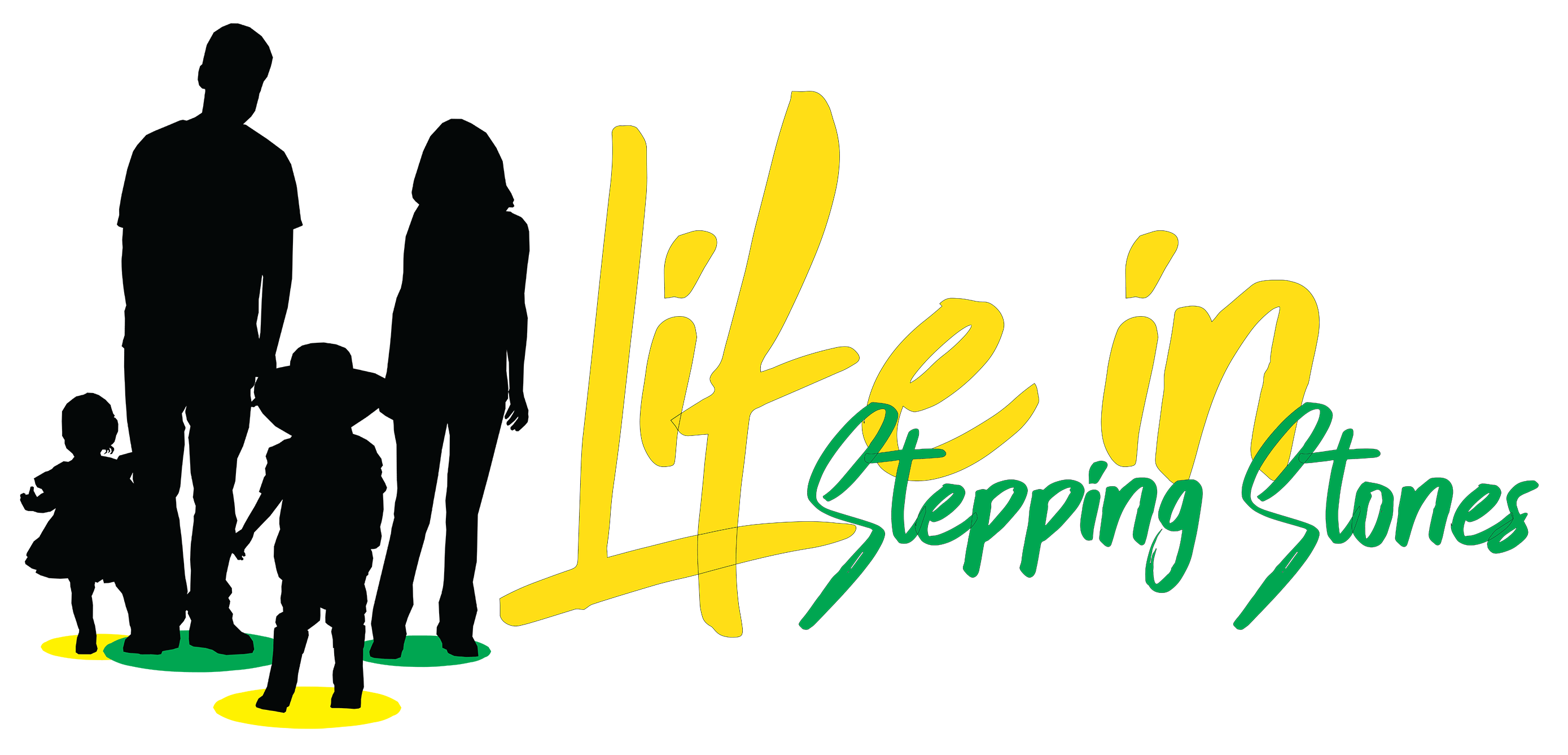
This was an awesome read. Such good ideas.
So sorry to hear you’ve had to personally deal with racism. I think you did a wonderful job teaching your son about such a delicate subject. By the way he is adorable!
Great suggestions! This is such an important lesson and if I can add one.. your children learn from what they see.. Be kind so no one ever has to feel unwanted!
I think discrimination and alternatively loving everyone is a topic for all ages. You are absolutely right to start the discussion young. Thank you for sharing!
Thank you! 👏 it’s so important to teach children & this is why the younger generations are so much more aware of the discrimination than our older generations (obviously not all and I’m generalizing). But they really are just more “woke” and this is an incredible way to stop discrimination from an early age!
I’m really impressed! 💜
I think these are great suggestions. Sometimes it’s hard to know where to start when it comes to little ones.
It’s so sad that we have to discuss these issues with our children. Your suggestions are a fantastic way to do it.
Well done!
I think its important to teach kids about this at a young age. I look back at my youth and wish someone had explained this to me so I knew that some of the instances that had happened wasn’t because of ME but because of the views of the people who had acted that way.
Yes, it is so important for kids to understand that when they are victimized that they are not the reason it’s happening. I personally dealt with discrimination because of health issues in school. I had teachers withholding my makeup assignments and locking my grade at a D because they didn’t want to give or grade my makeup work, and it led to me dropping out at 16. It took me years to gain back my self confidence and realize that my level of intelligence wasn’t dictated by these teachers. They clearly had their own prejudice and there was nothing I could’ve done to change that.
This is so informative! As a parent of a young child, I do wonder how I can teach this hard stuff to him. I think you did a fantastic job, and I will remember this and hopefully do just as well of a job!
You have so many good ideas for teaching children and grandchildren to be kind and always include others! I love that your cute little one wanted to make a sign to welcome everyone 🙂
Thank you 🙂 I was so proud of him when he asked to do that!!
Thank you for the excellent suggestions and sharing.
What a great lesson! My son is only 2, but it is so important to me that he know about races and discrimination. Zootopia would be a great movie for him!
Yes! Zootopia would be a perfect film to watch since he’s still a little too young to most likely grasp the other activities I discussed. The movie does a wonderful job of teaching these valuable lessons.
Thanks for these great tips on teaching kids about discrimination. Hard topics like this are difficult to explain to kids so they understand. Thanks for all the great suggestions!
We never needed to have these conversations with our children because they grew up color-blind in a Montessori Pre-school from age 2.5 with a very diverse culture of students that were just another friend at school. Our boys thought it odd that we talked with them in later years about these topics during public school… They simply didn’t understand why people would draw attention to a non-issue. That then makes it an issue that was not even present. Thus this perpetuates the social diversity issue.
Unfortunately, being color-blind doesn’t solve any of the problems in society. My dad has commented before that he grew up color-blind. I too never thought twice because people to me were all just people, regardless of skin tone, religion, etc. However, being aware of another person’s race doesn’t make someone prejudice, it just makes you aware of the many struggles that they are constantly facing in our current society. Being color-blind, however, can make a person less aware of the struggles people of color face. People don’t learn in school to be racist from educational and historical lessons. Opening a person’s eyes to other peoples struggles doesn’t create issues that didn’t exist, they raise awareness to issues that do. If we stopped educating about drugs and smoking, it wouldn’t stop teenagers from using. Discussing it doesn’t increase the risks, it decreases them. Raising awareness and educating people is the most important thing we can all possibly do, whether as educators or parents.
I think your tips and recommendations are excellent! It all starts in the home, and it should start there. Parents are such a huge influence for little kids. I way we’re teaching my son about how to be accepting of all people is to say – we are all human beings. Don’t judge somebody by the colour of their skin, ethnic background. If you must judge them, judge them by how they behave towards you and others. Everything else doesn’t matter.
I’m glad you enjoyed my post! I couldn’t agree more. It’s so important that our children are taught early not to judge others. It’s true that the only judgement should be based on how people treat you and others…and even then, it’s important kids understand too that people can still change as they grow (some sadly never do though!) and the way they treat you doesn’t even have to do with you most of the time. A girl that bullied me horribly in early elementary school ended up becoming a friend later in life because she was not anything like her 5 year old self.
Great suggestions. Sad that so many parents feel the need to not discuss such important topics. I can firmly say the best thing we did when raising our daughter (now 24 yrs) was to have open communication about everything.
What a great post, and I am sharing this! This is very important to share with everyone so most of us adults can start teaching our kids to stop racism while they are young.
Great way to teach your little one! Great idea!
I love the book recommendations! Going to look fir the series at our library!
Thank you! The entire series is absolutely wonderful! It’s the first series that has held my son’s attention 100% through. He’s normally a wiggle worm during story time but he LOVES these.
Great post, important information. I know my granddaughter -3 years old- has several books about how we are different but all the same. Seems like a no-brainer to me.
I think it is great to start taking about being accepting of others, even if they look different from us, at a young age. In my experience, children are very accepting and understanding. These are great activities for reinforcing the lesson, too.
These are all great suggestions. I love seeing what other moms are doing in regards to this subject. We drove our kids through some of the BLM gatherings in our city and saw it as an opportunity to discuss what was happening. And my elementary age kids get it. My 3-year-old is a bit different lol. But Zootopia was a great opportunity for us to discuss differences. Now that my oldest read Wonder in school, we also watched that as a family, and it provided an opportunity to discuss prejudice as well. As the kids enter early elementary school, we’ve also watched a lot of sports movies that deal with integration (like Remember the Titans). My kids are highly sensitive, so I haven’t discussed the violence behind this. But I know that will come as they get older. And when they are ready. Kudos to you for gently introducing your child to this. I enjoyed reading this post.
Wow – very heavy stuff , and excellent ways to bring awareness to your young one.
What a great way to teach young children about discrimination. Some great ideas and some great books.
It’s never too early to teach about diversity and acceptance! Bravo, and wonderful suggestions!
These are great ideas. If each parent took the time to teach their kids how to be kind to each other, the world would be a better place! Thankyou for sharing.
Such great ideas! When I first saw Zootopia, I was hoping that kids would be able to pick up on the subtle messages on discrimination.
These are wonderful teaching activities! It’s not too soon to begin teaching preschoolers about racism. I love that your son created an activity on his own. What a great boy!